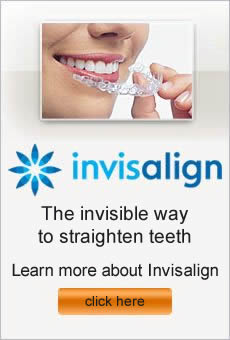While having to wear braces or other orthodontia may not be a lot of fun, most people enjoy straighter, gorgeous smiles because of this treatment time. The short-term hassles will produce lasting results. To get the maximum benefit from your orthodontic treatment, you need to follow these simple steps:
Be careful
Having braces shouldn’t impact your life in most cases, but you do need to make some adjustments. Stay away from hard foods and candies because they can damage brackets and wires. If you play sports, talk with your orthodontist about the type of mouth guard you need to wear with braces.
Follow instructions
Make sure to wear rubber bands, head gear, or other additional appliances as directed. Not wearing these devices can lengthen treatment time.
Don’t neglect your teeth
Though brushing and flossing are always important, they are particularly critical if you have braces. Food can easily get trapped between brackets and wires, creating a fertile breeding ground for bacteria and making your mouth susceptible to issues like tooth decay and gum disease.
Keep your appointments
Your orthodontist plans the visits at regular intervals to monitor the movement of your teeth and make necessary adjustments. Missing your scheduled appointment at the orthodontist can slow down your progress.
Continue regular dental visits
Because braces make routine oral care more difficult, you need to keep your appointments for semi-annual checkups. Your dentist and hygienist will examine your mouth and clean your teeth to promote good oral health.
Mehdi Fotovat Sherman Oaks Orthodontist
If you child plays any type of contact sport, you need to protect their face and mouth. More than seven million injuries are sustained by individuals from ages 5 to 24 during sports-type activities. The American Association of Orthodontists (AAO) recommends that anyone who participates in these events wear a mouth guard. With a mouth guard, you can reduce the risk of concussion by 50 percent.
Mouth guard basics:
• Made from plastic materials, mouth guards cover teeth and gums. Different types of mouth guards are available: stock, boil and bite, and custom.
• Stock mouth guards are the least expensive choice, but they don’t fit very well and they offer limited protection. You can find stock mouth guards at any sporting goods store.
• A slightly better choice, boil and bite mouth appliances are placed in hot water and then allowed to mold to the shape of your teeth. Boil and bite mouth guards can also be purchased from sport goods retailers.
• Custom mouth guards offer the best coverage. These devices are designed to fit your specific teeth and gums. Your orthodontist will take a model of your teeth and send it to a dental lab to construct the custom appliance.
• Once your orthodontist receives the mouth guard from the lab, you can schedule a return appointment to check the fit.
• To care for your mouth guard, store the device in a safe place when you aren’t wearing it and clean the mouth guard with warm water after each use.
• If you have braces, ask your orthodontist about what type of mouth guard to wear to protect your mouth.
It’s time to schedule a visit to our Sherman Oaks, CA orthodontic office – Mehdi Fotovat, DDS.
When you have space between your teeth, also called diastema, you should consult an orthodontist about the best way to deal with this issue. Though these spaces can occur between any two teeth, they most frequently appear between the two front teeth. A diastema can be caused by a variety of factors such as:
Missing or undersized teeth
When certain teeth don’t develop or if the permanent teeth are small, a space can occur. This situation frequently happens with the upper lateral incisors, the teeth next to the two upper front teeth.
An oversized labial frenum
The piece of tissue that usually stretches from the inside of your upper lip to the gum just above your two upper front teeth, the labial frenum may sometimes grow past the two front teeth. In this case, the tissue blocks the natural closure of the teeth.
Certain habits
Thumb sucking and pacifier use can create additional space, especially between front teeth.
Periodontal disease
When gum disease progresses, the results is loss of the bone that supports the teeth, which can make teeth loose and create space.
Temporary gaps from tooth loss
As primary teeth fall out and permanent teeth erupt, young children may develop a diastema. These spaces typically close once adult teeth move into their permanent position.
If you have a diastema, your orthodontist can perform a complete evaluation. After determining the cause of the space, the doctor can devise a treatment plan to close the gap and correct any alignment issues. Once the space is corrected, you should achieve a flawless smile.
We create beautiful smiles at our orthodontic dental practice in Sherman Oaks, CA – Mehdi Fotovat, DDS
When people think about orthodontics, they usually envision a mouth full of metal. While braces are part of orthodontic treatment, there are other phases as well. Depending on the case, you or a loved one may have several phases of treatment. To determine the right steps for your particular case, the orthodontist will perform a complete evaluation. Children should visit an orthodontist by age seven for a thorough assessment because some problems respond better before growth stops.
Phase One
Usually lasting 6 to 18 months, Phase One orthodontics involves children between the ages of 7 and 10. During this period, the primary goal is to address the position of the jawbone to prevent issues such as large overbites, cross bites, or facial asymmetries. Because this involves movement of underlying bone structure, Phase One is most successful for children who haven’t finished growing.
Phase Two
Most people are familiar with Phase Two treatment, which involves actual placement of braces on the permanent teeth to move them into proper alignment. Usually Phase Two occurs after a child stops developing. When adults decide on orthodontic treatment, it typically falls into this category. Though metal braces used to be the only option for Phase Two, ceramic brackets, lingual braces, and clear aligners enable patients to select from other methods of treatment.
After Braces
Once you finish with the braces, your orthodontist will take impressions for your retainers. These appliances will keep your teeth from shifting back into the old position. Initially, you will the retainers for almost 24 hours a day, but the time will be reduced as your orthodontist monitors your progress.
During orthodontic treatment, you need to take special care of teeth and gums. Extra brushing and additional flossing tools may become part of your routine. At the same time, you need to ensure that nothing happens to your braces. The following tips will help you protect your investment:
Eat right
While you have braces, you should avoid certain foods. Hard candy and sticky substances can crack brackets or break off wires. When you have apples or carrots, cut them in bite size pieces just to be safe.
Wear a mouth guard
For sports activities, you need to protect your face and mouth by having a mouth guard. Normally, dentists and orthodontists recommend custom mouth guards, but during orthodontic treatment you need the store-bought appliances so that your mouth guard won’t damage your braces.
Report problems immediately
Even when you do everything right, you may still have a broken bracket or loose wire. Apply dental wax if you experience discomfort and contact your orthodontist for the next step.
Curtail bad habits
Chewing on ice or biting your nails can harm your teeth and cause problems with your orthodontia.
Don’t make adjustments yourself
If your wires or brackets don’t seem right to you, call the orthodontist. Attempting to correct the issue can create bigger problems.
Visit the dentist for checkups
At these appointments, your dentist can make sure teeth and gums are holding up well during your time in braces. If enamel weakens or you develop gum disease, you could have trouble with your brackets and wires.
Protect your braces – Dr. Fotovat – Burbank Orthodontist – WebBraces.com



